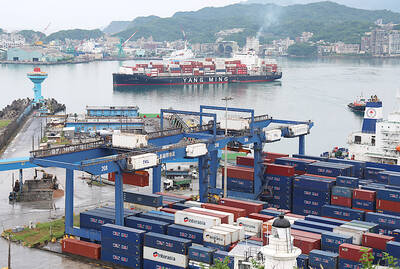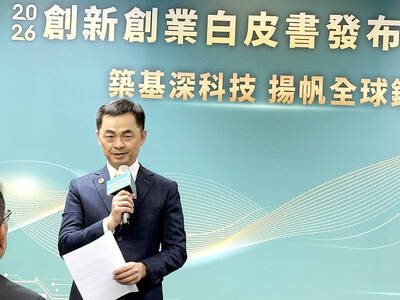Within the next couple years smart-control technology could make downtown cities cleaner as hybrid scooters switch from polluting petrol to electric power in crowded central districts if a Tainan-based green energy developer has its way.
With a NT$30 million grant from the government, Ji Ee Industry Co (
"The hybrid scooters will use a pure electric motor downtown to reduce emissions, and then when they go to the suburbs they can transform to gasoline," Jie Ee deputy vice president Charles Chiu (
A built-in computer system will sense when the scooter's speed drops below 25kph and automatically switch over to electric power, Chiu said.
This country has one of the highest concentrations of scooters in the world with over 10 million on the roads here in a population of 23 million, according to government estimates.
Last year, 600,000 new vehicles were added to the previous year's figures, Chiu said.
To prevent Taiwan's cities from choking under an ever increasing blanket of smog, the government offered hand-outs of NT$4,000 to everyone who bought electrically powered scooters, but canceled the scheme last year when less than 5 percent showed interest.
"Electric scooters don't have the range of gasoline ones," Chiu said.
"Our electric model has a range of 60km before it needs recharging. That means an effective radius of 30km, and most people didn't think that would be enough."
The government's new scheme to cut back on emissions is to funnel the electric scooter hand-out fund into reducing emissions through fuel injected engines.
Chiu worries this won't cut emissions enough in inner cities, which is why he secured government funding for the hybrid engine.
"Electric engines have zero emissions which is essential to reduce pollution in cities," Chiu said.
"In the suburbs the bikes can use the gasoline engine as there is more space. This has the added benefit that the gas engine can recharge the electric motor, eliminating the range problem of a purely electric model," he said.
Ji Ee's sister company, Eton Solar Tech Co (益通光能科技) is also trying to cash in on green energy.
The company makes solar cells for use in power-generating panels that appear on roofs, buildings, toys and consumer electronic goods such as calculators.
The government offers up to 50 percent of the cost of installing solar panels and a further 5 percent to 20-percent tax reduction for corporations that choose to go green with solar energy, Eton Solar's spokeswoman Ivette Chien (
The worldwide demand for solar energy increased by 32 percent last year from 390.52 megawatts (MW) in 2001 to 512.22MW last year, according to the solar industry's Photovoltaic Magazine.
Eton's solar cells are expected to produce 9MW of energy this year, but the company hopes to increase production to between 20MW and 30MW next year.
The company is also researching new solar technologies that may one day bring us an energy producing film that can be stuck to a window to produce electricity, Eton Group vice president Tsai Chin-yao (

CHIP RACE: Three years of overbroad export controls drove foreign competitors to pursue their own AI chips, and ‘cost US taxpayers billions of dollars,’ Nvidia said China has figured out the US strategy for allowing it to buy Nvidia Corp’s H200s and is rejecting the artificial intelligence (AI) chip in favor of domestically developed semiconductors, White House AI adviser David Sacks said, citing news reports. US President Donald Trump on Monday said that he would allow shipments of Nvidia’s H200 chips to China, part of an administration effort backed by Sacks to challenge Chinese tech champions such as Huawei Technologies Co (華為) by bringing US competition to their home market. On Friday, Sacks signaled that he was uncertain about whether that approach would work. “They’re rejecting our chips,” Sacks

Taiwan’s exports soared 56 percent year-on-year to an all-time high of US$64.05 billion last month, propelled by surging global demand for artificial intelligence (AI), high-performance computing and cloud service infrastructure, the Ministry of Finance said yesterday. Department of Statistics Director-General Beatrice Tsai (蔡美娜) called the figure an unexpected upside surprise, citing a wave of technology orders from overseas customers alongside the usual year-end shopping season for technology products. Growth is likely to remain strong this month, she said, projecting a 40 percent to 45 percent expansion on an annual basis. The outperformance could prompt the Directorate-General of Budget, Accounting and

NATIONAL SECURITY: Intel’s testing of ACM tools despite US government control ‘highlights egregious gaps in US technology protection policies,’ a former official said Chipmaker Intel Corp has tested chipmaking tools this year from a toolmaker with deep roots in China and two overseas units that were targeted by US sanctions, according to two sources with direct knowledge of the matter. Intel, which fended off calls for its CEO’s resignation from US President Donald Trump in August over his alleged ties to China, got the tools from ACM Research Inc, a Fremont, California-based producer of chipmaking equipment. Two of ACM’s units, based in Shanghai and South Korea, were among a number of firms barred last year from receiving US technology over claims they have

BARRIERS: Gudeng’s chairman said it was unlikely that the US could replicate Taiwan’s science parks in Arizona, given its strict immigration policies and cultural differences Gudeng Precision Industrial Co (家登), which supplies wafer pods to the world’s major semiconductor firms, yesterday said it is in no rush to set up production in the US due to high costs. The company supplies its customers through a warehouse in Arizona jointly operated by TSS Holdings Ltd (德鑫控股), a joint holding of Gudeng and 17 Taiwanese firms in the semiconductor supply chain, including specialty plastic compounds producer Nytex Composites Co (耐特) and automated material handling system supplier Symtek Automation Asia Co (迅得). While the company has long been exploring the feasibility of setting up production in the US to address